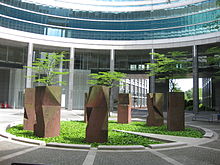Michelnauer Tuff
The Michelnau tuff , also known as basalt-red lava or red lava and known as Michelnau slag agglomerate , was broken up near Michelnau near Nidda in the Wetterau district in Hesse . The rock was formed in the Tertiary about 15 million years ago. The quarry has not been in operation since the mid-1990s.
Rock description and mineral inventory
It is a pale red slag agglomerate that shows partially reddish-gray areas. The red color was caused by finely distributed iron oxides. The texture of the rock is directionless, spongy and slag-like. It is very porous, the grain sizes vary depending on the type of mineral .
The Michelnau slag agglomerate has 64 percent glassy base mass, 32 percent zeolites and undefined foreign material, 2 percent pyroxene , and accessories such as olivine with less than 2 percent. There are zeolites in the pore spaces. The visible pore space was 51 percent, with misshapen pore spaces being larger and almost half filled with zeolites.
Rock deposits and quarry
The Vogelsberg is the largest closed basalt massif , in which volcanic tufa and slag agglomerate also occur. Other slags on the Hessian Vogelsberg are clay-bound. The Michelnau rock was formed millions of years ago by the eruption of a small volcano and is 14 meters thick on the Wingertsberg near Nidda.
Johann Weisel, farmer and landlord, began to break stones on the quarry site in 1863. The extraction of this rock was complex. Due to its properties as soft rock, no explosives could be used, as either the explosion energy evaporated or the rock material exploded into rubble and rubble. For this reason, slots had to be cut into the rock wall with axes or made with the help of a saw. With this extraction process, the block size could be freely selected according to the requirements. The cube-shaped raw blocks, which are still standing vertically in the rock wall today, were only firmly connected on their sixth side or rear wall after they had been exposed on five sides. It can be assumed that the blocks were wedged or sawed free with stone splitting tools before they were subsequently processed.
In the mid-1990s, the quarry ceased operations. The quarry has been used as a geotope since 2010 and is open to the public as part of guided tours.
use
The Michelnau tuff was used for solid structures as masonry, for bridge structures, church buildings and tombs in the vicinity of Nidda.
Gravestones in the Fulda central cemetery and the cemetery on Ockershäuser Allee in Marburg show numerous examples. This slag agglomerate was used as a building block in the church in Schotten, as a facade cladding for a supermarket in Nuremberg and in an extension to the historic town hall in Cologne . Stone sculptors preferred this stone because of its color and ease of manual processing. The sculpture of the Berlin Bear from Michelauer Tuff was known as a 500-kilometer milestone on the way to (West) Berlin, and also as a memorial at the Kestner School in Wetzlar . In the Protestant church of Ober-Lais , the altar, baptismal font, pulpit pedestal, floor and steps of the choir room are made of Michelnau tuff as well as the memorial crosses in the war cemetery of Arnsburg monastery , the Berlin bear fountain and sculptures in front of the Frankfurt Omega House.
In the past, the stone was also used as oven stone because it is heat-resistant and can store heat. In the Unter-Widdersheim bakery today (2009) an oven made of Michelnau tuff can still be seen. This furnace was built in 1935 and is put into operation once a year for a two-day celebration.
Michelnauer tuff is easy to work with, its compressive strength and weathering resistance are low, it grusts and sands quickly when it is installed outdoors. Because of its porosity, organisms are quickly attacked. When used as natural stone , only a matt finish and no polish can be achieved.
Web links
- Friends of the Michelnau quarry e. V.
- Vogelsberg earth shop window with description of the quarry p. 8 (PDF file; 1.19 MB)
Individual evidence
- ↑ R. Weyl (ed.): Geological guide Gießen and surroundings. 2nd edition, revised by F. Stibane , p. 153, Mittelhessische Druck- und Verlagsgesellschaft, Gießen 1980.
- ↑ Wolf-Dieter Grimm: Pictorial Atlas of Important Monument Rocks of the Federal Republic of Germany , ed. from the Bavarian State Office for Monument Preservation, Gesteins No. 048, Lipp-Verlag. Munich 1990. ISBN 3-87490-535-7 .
- ↑ Hesse raw material security concept, report on natural stones and natural stone. (PDF; 5.3 MB) 12.6.5. Dismantling situation and use . Hessian State Office for Environment and Geology, November 20, 2006, p. 89 , accessed on February 16, 2014 .
- ↑ a b c Chronicle Unter-Widdersheim .
- ↑ a b Michelnau quarry - framework concept for conservation and possible development. (PDF; 13.3 MB) Deutsche Vulkanologische Gesellschaft eV Vulkan Vogelsberg Section, November 2009, accessed on February 16, 2014 . ( Short version ).
- ^ Excursion 2007. Vogelsberg network, 2007, archived from the original on June 16, 2007 ; accessed on February 16, 2014 .
- ↑ (red): Great achievements in just five years. Balance sheet. Pioneering spirit brings quarry to life / Association of Friends takes exemplary care of preservation / Info center a topic , Kreis-Anzeiger, Monday, May 18, 2015, p. 10.
- ↑ W. Dienemann and O. Burre: The usable rocks Germany and their deposits with the exception of coal, ores and salts, S. 96, Enke-Verlag, Stuttgart 1929th
Coordinates: 50 ° 25 '18 " N , 9 ° 2' 23.9" E




